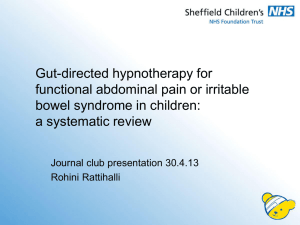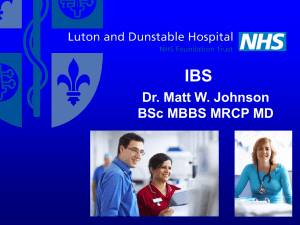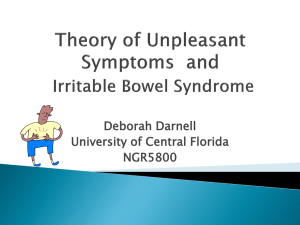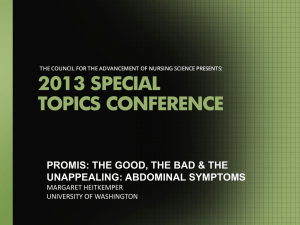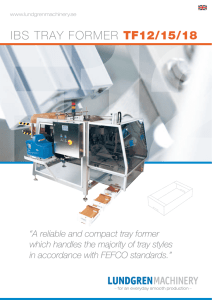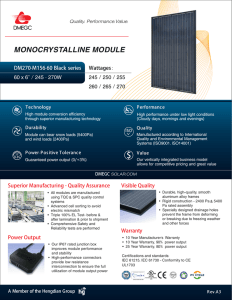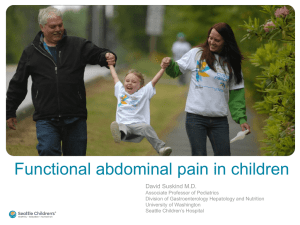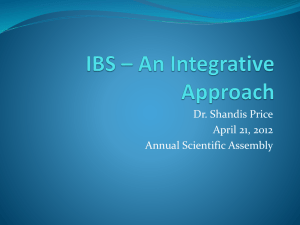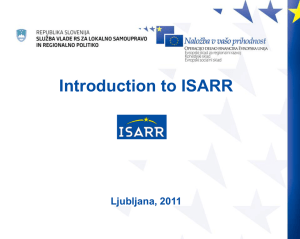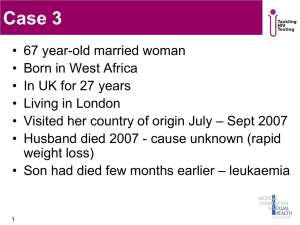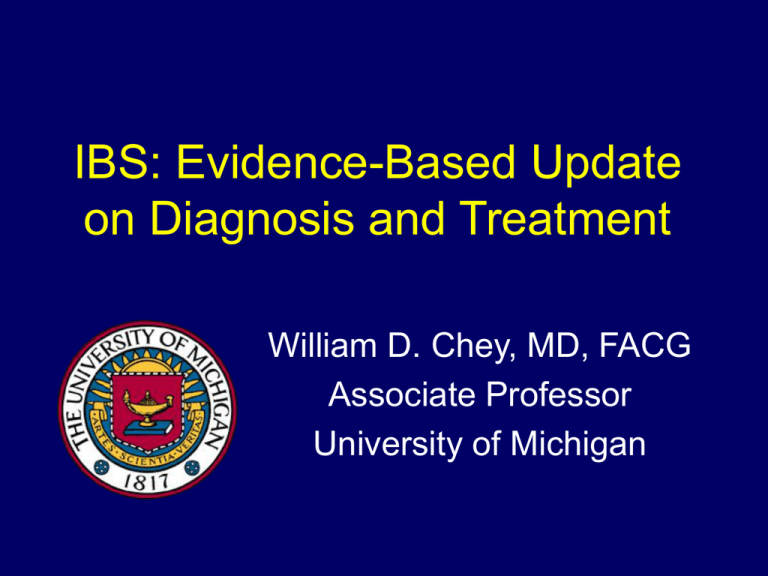
IBS: Evidence-Based Update
on Diagnosis and Treatment
William D. Chey, MD, FACG
Associate Professor
University of Michigan
“A good set of bowels is worth
more to a man than any
quantity of brains”
Josh Billings (Henry Wheeler
Shaw) 1818-1885
“There is nothing in life as
underrated as a good bowel
movement”
William D. Chey, MD
1960-?
Arriving at a confident
diagnosis of IBS
Rome II Criteria for IBS
• Abdominal pain or discomfort for at least 12
weeks (which need not be consecutive) in the
preceding 12 months
• Abdominal pain or discomfort has 2 of 3 features:
—Relieved with defecation
—Onset associated with a change in
stool frequency
—Onset associated with a change in stool form
• 97% of patients with IBS have no changes in diagnosis
over 5 years
Thompson WG, et al. Gut. 1999;45(suppl II):II43-II47
The Confident Diagnosis of IBS:
A Symptom-based Approach
Use symptom-based diagnostic criteria for IBS
Exclude Alarm Symptoms
(weight loss, fever, bleeding, family history of cancer/IBD)
Perform physical exam and selected diagnostic tests
to rule out organic disease
Make a confident diagnosis of IBS
Initiate a treatment plan based on symptoms
Follow up in 3 to 6 weeks
Modified from Paterson WE, et al. Can Med Assoc J. 1999;161:154; American
Gastroenterological Association. Gastroenterology. 1997;112:2120; Camilleri M,
Choi MG. Aliment Pharmacol Ther. 1997;11:3.
Confident diagnosis of IBS:
Validity of a symptom-based approach
• A 2-year retrospective study confirmed the validity
of an approach combining the Rome I criteria and absence
of Red Flags. Results showed:
100%
100%
Specificity
Positive
predictive value
65%
Sensitivity
• At 2-years follow-up, no patients required revision
of diagnosis
Vanner et al, Am J Gastroenterol 1999; 94: 2912
Limitations of the Rome II
criteria in clinical practice
100
83
85
82
Sensitivity
80
60
40
Total n=1014
GI n=313
Non-GI n=701
20
Gold standard =
Dx of IBS by MD
47
49
47
0
Rome I
Rome II
Difference in sensitivity largely due to pain
requirement of Rome II
Chey. Am J Gastroenterol 2002;97:2803
Practical Definition of IBS
• Rome criteria were developed for clinical
research and are currently being revised
• Practical definition for clinical practice:
•
IBS is a chronic medical condition
characterized by abdominal pain or
discomfort in association with alterations in
bowel function
• pain relieved with defecation
• alteration in stool frequency
• alteration in stool form
Differential Diagnosis of IBS
Infection
Dietary factors
lactose, sorbitol
fructose
caffeine, alcohol
fat
Giardia,
Ameba
bacterial overgrowth
IBD
ulcerative colitis
Crohn’s disease
microscopic colitis
gas-producing foods
Differential
diagnosis
Malabsorption
Psychologic
celiac sprue
post-surgical
pancreatic
anxiety/panic
depression
somatization
Miscellaneous
endometriosis
endocrine tumors
Which tests are necessary in
suspected IBS?
Pretest Probability of Organic Disease
Organic GI Disease
IBS Patients
General Population
(Pretest Probability %)
(Prevalence %)
0.51-0.98
0.3-1.2
0-0.51
4-6
Celiac disease
4.67
0.25-0.5
Gastrointestinal infection
0-1.7
N/A
6
5-9
22-26
25
Colitis / IBD
Colorectal cancer
Thyroid dysfunction
Lactose malabsorption
Cash, et al. Am J Gastroenterol 2002;97:2812
Celiac Disease and IBS
• US prevalence of celiac disease1
– Overall 1:133, First degree relative 1:22,
Symptomatic pts 1:56
• UK study: 14/300 (5%) IBS pts had biopsy proven
celiac sprue2
• Irish study: 30/150 (20%) sprue pts met Rome
criteria vs 8/162 (5%) controls3
• German study: of 102 IBS-D pts, 0% had serum Ab
but 30% had Ab in duodenal aspirate4
1Fasano.
Arch Int Med 2003;163:286. 2Sanders. Lancet 2001;358:1504.
3O'Leary. Am J Gastroenterol 2002;97:1463. 4Wahnschaffe. Gastroenterol
2001;121:1329.
Is it cost-effecitve to test for
Celiac Disease in IBS?
• Decision analytic model assessed the costeffectiveness of celiac testing vs. empiric IBS
therapy in pts with suspected IBS
• Testing cost an incremental $11K for one additional
symptomatic improvement
– ICER >%50K when prevalence of CS<1%
– Testing dominant when prevalence of CS>8%
• Factors affecting the decision to test:
– Prevalence of CS, test accuracy, cost of IBS therapy,
likelihood that symptoms improve on a gluen-free diet
Speigel, et al. Gastroenterol 2004;126:1721
Bacterial Overgrowth and IBS
50
*
*
40
40
35
30
%
*
ITT decrease Composite
Score
Normal symptoms
20
20
Normal LBT
15
11
*P<0.05
10
2
0
Placebo n=56
Neomycin n=55
Pimental. Am J Gastroenterol 2003;98:412
Post-infectious IBS
• Incidence of IBS after acute bacterial gastroenteritis
ranges from 7% to 32%1-3
– ~60% remain symptomatic over 6 years of follow-up
– Usually diarrhea predominant
• Psychological distress and severity/duration are predictive
– Campylobacter/Shigella > Salmonella
• Results from immune system activation
– Altered gut transit4
– Increased rectal sensitivity2
– Increased intestinal permeability4
– Increased 5-HT–containing enterochromaffin cells in the colon4
1Neal
KR, et al. BMJ. 1997;314:779-782
2McKendrick MW, et al. J Infect. 1994;29:1-3.
3Gwee
KA, et al. Lancet. 1996;347:150-153.
RC, et al. Gut. 2000;47:804-811.
4Spiller
Inflammation and IBS
Celiac Sprue
Mucosal and
Enteric Inflammation
Inflammation
Post-infectious
Stress
Small Bowel
Bacterial
Overgrowth
Evidence of heredity in IBS
• Increased frequency of IBS and dyspepsia
in adults with an affected first-degree relative
Mayo Clinic study, Olmstead County, MN1
• Monozygotic twins more likely to be concordant for
IBS than dizygotic twins.
US twin study2
• >50% of liability to functional bowel disorders might
be subject to genetic control3
Australian twin study3
1Locke
et al, Mayo Clin Proc 2000; 75: 907
et al, Gastroenterology 2001; 121 : 799
3Morris-Yates et al, Am J Gastroenterology 1998; 93: 1311
2Levy
Treatment of IBS:
Where are we now?
Symptom-based medical
treatment of IBS
Abdominal pain / discomfort
Antispasmodics
Antidepressants
• TCAs / SSRIs
• Alosetron
• Tegaserod
Diarrhea
Abdominal
pain /
discomfort
Loperamide
Other opioids
Alosetron
Bloating /
distention
Altered bowel
function
Constipation
Fiber
MOM/PEG solution
Tegaserod
Brandt, AJG 2002;97:S7
Drossman, Gastroenterology 2002;123;2108
Fiber/Bulking Agents for IBS
• 14 RCTs published in English
• All have significant methodological flaws
• Psyllium/Ispaghula husk (20-30 grm/day)
improves constipation
– Bran does not appear to be effective
• Data does not support the use of fiber for
abdominal pain or diarrhea
• No RCTs have evaluated other laxatives for
IBS
Brandt, AJG 2002;97:S7
Anti-spasmodics for IBS
• Anti-cholintergics, anti-muscarinics, Cachannel blockers
• 18 RCTs published in English
• Substantial methodological flaws
• Several agents found to improve global
symptoms or pain
– None available in the US
• No convincing evidence that dicyclomine or
hyoscyamine are effective
Brandt, AJG 2002;97:S7
Jailwala, Annals Int Med 2000;133:136
Poynard, APT 2001;15:355
Loperamide for IBS
• Loperamide favored over other opiates
– does not cross the blood-brain barrier
– effects on anal sphincter pressure?
• Dose: 2-4 mg up to QID
• 3 RCTs published in English
– Trials small (28-69) and of short duration (3-5wk)
• Improvements in diarrhea but not global
symptoms or pain
Brandt, AJG 2002;97:S7
Anti-depressants for IBS
• Reserve for moderate to severe symptoms
• Tricyclic antidepressants
– 7 RCTs for Tricyclics published in English
• Studies of low quality1
– TCAs appear to be effective at low doses
– Recent meta-analysis found improvement in global symptoms
(OR=4.2) and pain2
• NNT = 3.2
– Constipation, sedation, weight gain common
• Selective serotonin reuptake inhibitors3
– Conflicting results
• Venlafaxin but not fluoxetine may decrease colonic sensation
– Likely more effective with co-morbid anxiety or depression
1Brandt, AJG
2002;97:S7
2Jackson, Am J Med 2000;108:65
3Clouse, Gut 2003;52:598
4Chial,
Clin Gastroenterol Hepatol 2003;1:211
5Kuiken Clin Gastroenterol Hepatol 2003;1:211
TCA vs. Placebo for
Moderate to Severe FGIDs
Desipramine
100
% Responders
80
Placebo (12 wks)
P=0.006
NNT=4
73
P=0.13
60
60
47
49
ITT n=201
PP n=153
Better response
in pts with moderate
symptoms and IBS-D
40
20
0
Drossman, Gastro 2003;125:19
TCA's for FGID's:
Moderate / Severe Side Effects
Desipramine (n=135)
Placebo (n=55)
% Reporting AE
40
30
26
20
20
16
11
13
13
8
10
2
0
Dry Mouth
Sleep
•8 fold increase in study drop outs with TCA
•Multiple side effects common (mean = 3.5)
Constipation
Flush
Drossman, Gastro 2003;125:19
Paroxetine vs. Placebo for
IBS unresponsive to fiber
Paroxetine n=38
Placebo n=43
(12 wks)
P=0.001
100
84
% Responders
80
P=0.01
No improvements in
abdominal pain,
bloating, social fxning
63
60
37
40
26
20
0
Overall WB
Wished to continue
Tabas, Am J Gastro 2004;99:914
Treatment of IBS:
Where are we headed?
Evolving model of IBS
Brain-Gut
Interactions
Psycho-social
Factors
ANS
Visceral
Hypersensitivity
Altered
Motility/Secretion
Inflammation
Adapted from Coulie. Clin Perspect Gastroenterol. 1999;2:329-338.
Emerging Therapies
for IBS
• Pain modulation
– Serotonin modulators
– Benzodiazepine derivatives
• R-tofisopam
– Neurokinin antagonists
• NK 1, 2, 3 receptor antagonists in development
– CRF antagonists
– Opioid receptor modulators
• Asimadoline, fedotozine
– M3 antagonists
• Zamifenacin
– Octreotide
Relevance of Serotonin
to IBS
• Modulates gastrointestinal motility
and secretion
• Important to visceral perception
• Involved in CNS function
5-HT3 Antagonists for IBS
• Visceral afferent effects
• ENS effects
– delays colonic transit
– decreases colonic tone
– inhibits CI- secretion
• Blunts the gastro-colonic response
• Central Effects
– anti-emetic properties
– benefits in anxious or neurotic?
Kim, Am J Gastro 2000;95:2698
Clinical trials of Alosetron vs.
placebo for D-IBS
Reference Pts
%
Female
% Responders for Primary Outcome
Therapeutic
Alosetron Placebo
gain
Camilleri*
370
53
60%
33%
27%
Camilleri*
647
100
41%
29%
12%
Camilleri*
626
100
43%
26%
17%
Lembo**
801
100
73%
57%
16%
D-IBS=IBS with diarrhea
Primary outcome = abdominal pain*
or urgency**
Long-term efficacy of Alosetron
in women with IBS-D
Alosetron, n=279
Placebo, n=290
48 wks
100
% Responders
80
60
P = 0.001
NNT = 8
P = 0.01
NNT=12
52
64
44
52
40
20
0
Abd pain
Urgency
Chey, Am J Gastroenterol. 2004;99:2195.
Alosetron: A long strange trip…
• Alosetron
– approved 2/00: improved abdominal pain and
bowel-related symptoms in diarrheapredominant females with IBS1
– side effects: constipation, ischemic colitis,
death
– voluntarily withdrawn (11/00)
– re-approved July 2002
• for females with severe diarrhea-predominant IBS
who have failed to respond to conventional therapies
• 12 month safety and efficacy trials
completed2,3
Camilleri, APT 1999;13:1149
1
2Wolfe,
AJG 2001;96:803
3Chey, AJG 2004;99:2195
Cilansetron for IBS-D:
Phase III Study Results
Cilansetron (males)
70
% Responders
60
50
Placebo (males)
P=<0.006
52
P=<0.001
P=<0.073
55
45
41
37
40
30
20
18
10
0
3 months
3 months
US Study1
N = 205
6 months
Multinational Study2
N = 358
1Miner
Am J Gastroenterol 2004;99:S277
Gastroenterol 2004;126:A42
2Bradette
Phase III Clinical trials with
Cilansetron: Safety data
Adverse event (% C vs P)
Study [ref]
Constipation
Headache
Abdominal Pain
Ischemic colitis
US [1]
19 vs 4
6 vs 3
6 vs 1
0.29 vs 0
Multinationa
l [2]
12 vs 3
10 vs 10
5 vs 4
0.76 vs 0
C: Cilansetron; n: number of subjects; NR: not reported; P: Placebo
1Miner
Am J Gastroenterol 2004;99:S277
2Bradette Gastroenterol 2004;126:A42
5-HT4 Agonists for IBS
• Tegaserod is a specific 5-HT4 agonist
• ENS effects
– Augments the peristatic reflex1
– Accelerates orocecal transit and cecal
emptying2
– Stimulation of CI-/H20 secretion3
• Possible visceral afferent effects4
1Grider, Gastro 1998;115:370
2Prather, Gastro 2000;118:463
3Stoner, Gastro 2000;116:A648
4Coffin, Gastro 2002;124:A407
Clinical trials of Tegaserod vs.
placebo for C-IBS
% Responders for Primary Outcome
Reference Pts
Muller
881
%
Female
83
Therapeutic
Tegaserod Placebo
Gain
38%%
30
8%
Krumholz
799
87
46%
33%
13%
Novicki
1519
100
44%
39%
5%
Kellow
520
88
47%
28%
19%
Global endpoint
Kellow – non-D IBS
Müller-Lissner. Aliment Pharmacol Ther 2001;15:1655–66
Krumholz. Gut 1999;45(Suppl.V):A260
Novick. Aliment Pharmacol Ther 2002;16:1877–88
Kellow. Gut 2003;52:671
Secondary efficacy variables:
Effect of tegaserod
• Tegaserod produced a statistically significant
reduction in abdominal discomfort / pain
• Patients on tegaserod experienced a significant
increase in the number of bowel movements
• Tegaserod significantly improved stool consistency
vs placebo
• Tegaserod produced a significantly greater
reduction in bloating score vs placebo
Müller-Lissner et al, Aliment Pharmacol Ther 2001; 15: 1655
Novick et al, Aliment Pharmacol Ther 2002; 16: 1877
Kellow et al, Gut 2003; 52: 671
Tegaserod: Safety Summary
• Safety similar to placebo except for diarrhea and
headache
• Diarrhea
– tegaserod 8.8% vs. placebo 3.8%
– occurred early and was typically transient
– more common in alternating constipation/diarrhea
• Headache
– tegaserod 15% vs. placebo 12%
– does not cross the blood-brain barrier
• No significant increase in abdominal or pelvic
surgery in patients treated with tegaserod
• Safety data available for up to 12 months
Tougas, APT 2002;16:1701
IBS and Ischemic Colitis
• Little data on the background prevalence of
IC in general population or pts with
suspected IBS
– Systematic review1 reported a rate of IC in the
general population of 4.5 to 44 cases/100,000
person years
– United Healthcare data base: prevalence of IC in
IBS = 43:100K person years vs. 7.2:100K in
controls (RR-3.4)2
– Medi-Cal data base: prevalence of IC in IBS =
179:100K person years vs. 47:100K in controls
(RR-3.15)3
1Higgins
APT 2004;19:729
3Singh Gastroenterol 2004:126:A41
2Cole
Am J Gastro 2004;99:486
IBS and Ischemic Colitis:
Why the Association?
• Misdiagnosis?
• Case Finding?
• Common link in pathogenesis of IBS
and ischemic colitis?
– Molecular changes in serotonin
signaling identified in IBS and UC1
1Coates
Gastroenerol 2004;126:1657
Serotonin Modulators and
Ischemic Colitis
Gen Pop
Cases per 100K
Person-years
4.5-47
IBS
43-179
*All cases of IC in post-marketing
**After adjudication
Alosetron Tegaserod
190*
110**
7
Higgins APT 2004;19:729
Cole AJG 2004;99;486
Singh DDW 04
Chey DDW 05
Novartis data on file
Emerging Therapies
for IBS
• Candidates for IBS-C
–5-HT4 agonists
–Chloride channel activators
• SPI-0211
–Opioid antagonists
• Naloxone, methylnaltrexone, LY 246736
–5-HT3 agonists?
• MKC-733
Emerging Therapies
for IBS
• Candidates for IBS-D
–5-HT3 antagonists
–α-receptor agonists
• Clonidine
–5-HT4 antagonists?
• Piboserod, sulamserod
Emerging Therapies for IBS
Brain-Gut
Interactions
R-tofisopam
Psycho-social
Factors
Serotonergic agents
CRF antagonists
NK antagonists
α-receptor agonists
Visceral
Hypersensitivity
Altered
Motility/Secretion
Opioid antagonists
Cl-CA
Opioid agonists
Inflammation
It’s not just yellow snow you
shouldn’t eat!
Treatment of IBS:
Psychological Therapies
Psychological Therapies for IBS
•
•
•
•
Cognitive-behavioral therapy
Hypnotherapy
Relaxation/Stress management
Interpersonal therapy
Drossman, Gastroenterology 2002;123;2108
CBT vs. Education for
Moderate to Severe FGID's
100
P<0.001
NNT=3
% Responders
80
P<0.001
NNT=3
73
70
60
40
37
41
CBT
Education
12 wks
20
0
ITT n=201
PP n=168
Drossman, Gastro 2003;125:19
Predictors of Response
to Psychotherapy
Non-constant
pain
Awareness
of stress
Short
symptom
duration
Predictors of good
response
Anxiety/
depression
Predominant
pain or diarrhea
Drossman, Gastroenterology 2002;123;2108
Treatment of IBS:
Alternative therapies?
Use of Alternative Medicine
in the US
• Use of Alternative Medicine increased from 34%
in 1990 to 42% in 1997
• Relaxation techniques (16%), herbal remedies
(12%), massage (11%) most common
• Most commonly for chronic conditions
– Back pain, anxiety, depression, headache
– IBS most common amongst GI problems2
– >20% of IBS/FD pts use alternative medicine3
• $21.2 billion in 1997
– $12.2 billion out of pocket
Eisenberg, JAMA 1998; 280:1569
2Smart, Gut 1986;27:826
3Koloski, APT 2003;17:841
Chinese Herbal Medicine for IBS
Plac. n=35
Standard n=43
Individualized n=38
200
160
120
*
*
*
IBS=Rome I
5 caps TID x 16 wks
BSS
* p < 0.05
80
40
0
End of therapy
14 wk FU
Bensoussan, JAMA 1998; 280:1585
Acupuncture for IBS
5
General well-being (VAS)
4.1
*p=0.05
4.1
3.7
3.6
4
*p=0.15
Acupuncture
Placebo
3
11 wk crossover trial
n = 25 (PP analysis)
2
Acupuncture at LI-4
1
0
Visit 1
Visit 2
No change in pain or stool characteristics
Fireman, Digestion 2001;64:100
Probiotics for IBS
• Probiotic bacteria may have antiinflammatory effects on the GI mucosa
• 2 four wk studies found that L plantarum was
better than placebo for IBS
– abd pain1,2, flatulence2
• VSL #3 improved bloating but not global
symptoms, pain, urgency or transit in IBS
with diarrhea3
1Niedzielin
Eur J Gastro Hepatol 2001;13:1143
2Nobaek Am J Gastroenterol 2000;95:1231
3Kim APT 2003;17:895
Treatment of IBS: Summary
• Much of the traditional treatment of IBS is
based on faith rather than evidence
• Evidence suggests that newer therapies
including alosetron and tegaserod are
beneficial
– Other classes of drugs are in
development
• Psychological therapies may be effective
• Alternative therapies appear promising
but require further study

